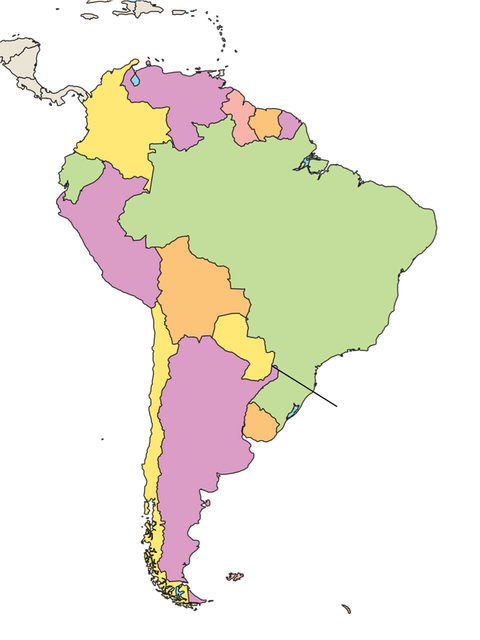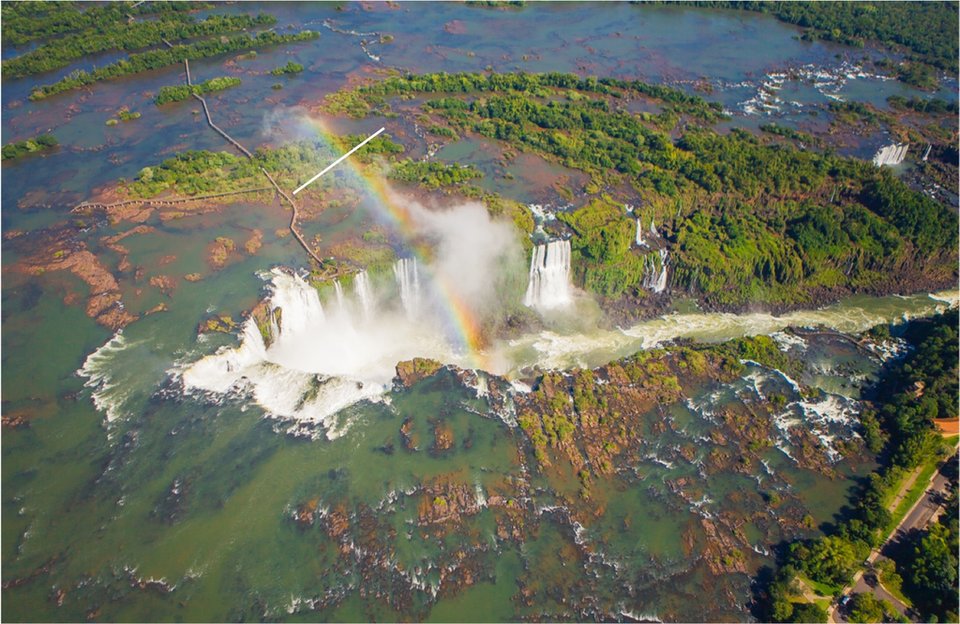Afterwalkingthroughthehotandhumidrainforest,Ihadfinallyreachedthelast,longfootbridge.AheadofmelaytheDevil’sThroat.Icouldhearitssteadyroar.ThecloserIgot,thelouderit became.
Iinchedforwardtotheedgeofthefootbridge.Peeringoverthebalcony,Icaughtsightofthismassivewaterfall.Mistfromthewaterroseintotheair.Iwassoakingwetwithin minutes.
Beforeme,themightyIguazúRiverplungedoverarocky,U-shapedcliff.Downintoadeepandnarrowcanyonitfell.Itwas breathtaking.
GreatWater
IguazúFallsgotitsnamefromtheGuaranípeople.Itsnamemeans“greatwater.”Thewatertherivercarriesoverthefallsis astounding.
Onaverage,theIguazúRiverflowsatarapidrate.WhenitrainsfromNovembertoMarch,itcancarrymorethanseventimesthat much!

Iguazú Falls
Atlantic
Ocean
Pacific
Ocean
Brazil
Paraguay
Argentina
South
America
IguazúFallsisoneofthelargestwaterfallsystemsintheworld.ItspanstheborderofArgentinaandBrazil.Duringtherainyseason,upto275 differentwaterfallscan form.
Abouttwo-thirdsofthefallsareontheArgentiniansideoftheriver.IcrossedtheborderintoBrazil.Iracedupthechurningriverinaspeedboat.Theboatslowedatthefootofseveralwaterfallstogivemeacloser view.
It’shardtoappreciatethespectacularfallsuntilyouhaveseenthemforyourself.Uponvisitingthefalls,afirstladyoftheUnitedStates,EleanorRoosevelt,said,“PoorNiagara.”NiagaraFalls,betweentheU.S.andCanada,ishalfastallandhalfas wide.
Seenfromtheair,Devil’sThroatdividesArgentinaand Brazil.

trailtoDevil’s Throat
Argentina
Brazil
Devil’s Throat
LegendoftheFalls
ThereisalegendthattellshowtheIguazúFallscametobe.IntheGuaranítale,theserpentgodM’BoilivedintheIguazúRiver.M’Boiwasanangrygod.Eachyear,thepeoplemadeasacrificetoquiethim.Theythrewayoungwomanintothe water.
Oneyear,thetribechoseNaipi.NaipiwasabouttomarryawarriornamedTarobá.Thenightbeforethesacrifice,sheandTarobátriedtoescapeinacanoe.But,M’Boisaw them.
Tarobápaddledhard,buttheserpentgodwasmighty.Hesplittheearth,creatingarockygorge,Devil’sThroat.NaipiwasthrowntoonesideofthegorgeandTarobátotheother.M’BoichangedNaipiintoa rock.AsTarobátriedtohelpher,M’Boipulledhishandsintotheearth.Hisfingersturnedintoroots.Hisbodybecameapalmtree.AndsoNaipiandTarobáonlycanmeetoverarainbowtoshowtheirloveforone another.
Arainbowbridgesthe falls.